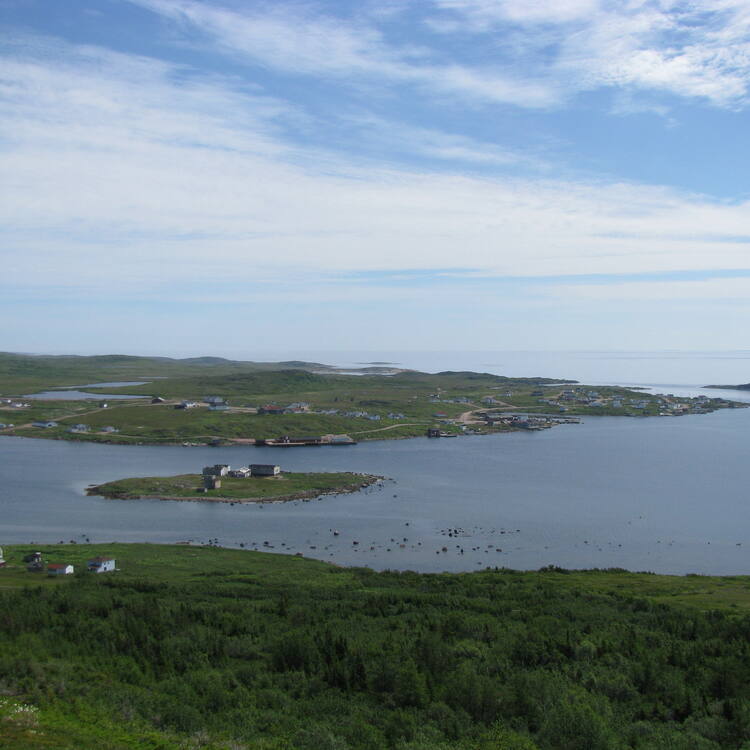Red Bay Basque Whaling Station
Red Bay Basque Whaling Station
Red Bay, established by Basque mariners in the 16th century at the north-eastern tip of Canada on the shore of the Strait of Belle Isle is an archaeological site that provides the earliest, most complete and best preserved testimony of the European whaling tradition. Gran Baya, as it was called by those who founded the station in 1530s, was used as a base for coastal hunting, butchering, rendering of whale fat by heading to produce oil and storage. It became a major source of whale oil which was shipped to Europe where it was used for lighting. The site, which was used in the summer months, includes remains of rendering ovens, cooperages, wharves, temporary living quarters and a cemetery, together with underwater remains of vessels and whale bone deposits. The station was used for some 70 years, before the local whale population was depleted.
Description is available under license CC-BY-SA IGO 3.0
Station baleinière basque de Red Bay
Red Bay, installée par des marins basques au XVIe siècle sur les rives du détroit de Belle-Isle, est un site archéologique qui constitue le témoignage le plus ancien et le plus complet de la tradition européenne de la chasse à la baleine. Gran Baya – le nom donné par les fondateurs en 1530 – servait de base à la chasse côtière, au dépeçage, à l’extraction de l’huile et à son stockage. Vendue en Europe, l’huile était la principale source d’éclairage. Le site, qui n’était habité que pendant l’été, comprend des vestiges de fourneaux (fondoirs), d’ateliers d’assemblage de tonneaux, d’un wharf, de bâtiments d’habitation, d’un cimetière, ainsi que des vestiges sous-marins (épaves de bateaux et ossuaires de baleines). L’endroit a servi pendant près de 70 ans avant que la population locale de baleines ne s’effondre.
Description is available under license CC-BY-SA IGO 3.0
Estación ballenera vasca de Bahía Roja
source: UNESCO/CPE
Description is available under license CC-BY-SA IGO 3.0
レッドベイのバスク人捕鯨基地
source: NFUAJ
Red Bay Baskisch walvis(verwerkings)station
Source: unesco.nl
Outstanding Universal Value
Brief synthesis
Situated in Labrador, in north-eastern Canada, on the shores of the Strait of Belle Isle, Red Bay was an Arctic maritime base for Basque mariners in the 16th century. It is the earliest, most comprehensive and best preserved archaeological testimony of a pre-industrial whaling station. It was used for coastal whale hunting in the summer, the butchery of the whales, and the rendering of the oil and its storage. The whale oil was sold in Europe primarily for lighting purposes. The property includes the remains of rendering ovens, cooperages, a wharf, living quarters and a cemetery, together with the underwater wrecks of vessels and whale bone deposits.
Criterion (iii): Red Bay Basque Whaling Station is an outstanding example of the tradition of whale hunting established by the Basques in the 16th century for the production of oil which was transported for sale in Europe. In terms of the diversity of its archaeological remains, this is the most extensive, best preserved and most comprehensive whaling station of this type.
Criterion (iv): Red Bay Basque Whaling Station constitutes a fully intelligible ensemble of archaeological elements illustrating the establishment of a proto-industrial process of large-scale production of whale oil, during the 16th century.
Integrity
The property includes all the terrestrial and underwater elements that illustrate all the major phases of the whale hunting process. The various attributes of the property are generally well preserved, and their relationships with the land remain engraved on and visible in the landscape. They therefore satisfactorily express the Outstanding Universal Value of the property; however, as visibility of the remains is limited, a policy of active and thorough interpretation is necessary. The knowledge of the socio-technical system involved is sufficient to allow full interpretation of the ensemble of preserved remains at Red Bay.
Authenticity
The various attributes of the property are of unquestionable authenticity, as is the general landscape around the present-day village of Red Bay. However, the authenticity perceived by the visitor remains limited to an impression of the landscape, as the tangible attributes have been reburied, which is however justified in view of the need for conservation. The Visitor Interpretation Centre is essential to enable an understanding of the site and its authenticity.
Protection and management requirements
Red Bay was listed as a National Historic Site of Canada in 1979. The property management and protection plan has been in place for a long time; it is effective, and the responsibilities of each of the players are clearly identified. The Management Committee was set up at the end of the preparation of the nomination dossier, between the four institutional property management partners. The Management Plan for Red Bay, the National Historic Site of Canada is designed to be used in conjunction with the Management Plan for the Red Bay Whaling Station, which brings together all the partners involved in the management of the property. At present, the protection of the property – following an intensive phase of archaeological research from the 1970s to the 1990s - is ensured by the permanent covering and reburying of both terrestrial and underwater remains. Current management thus consists of monitoring the state of conservation and developing structures for visitor interpretation and reception.

